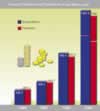|
ECONOMY|AGRICULTURE|INDUSTRY|CONSTRUCTION|INVESTMENT IN FIXED ASSETS|TRANSPORTATION|POSTS AND TELECOMMUNICATIONS|BANKING, SECURITIES AND INSURANCE|DOMESTIC TRADE|FOREIGN ECONOMIC RELATIONS |
|||||||
|
Summary |
|||||||
| |
|||||||

|

|

|
|||||
|
In 2000, under the correct leadership of the Party Central Committee and the State Council, various localities and departments earnestly implemented a series of policies for the expansion of domestic demand, a pro-active financial policy and a prudent monetary policy, while making great efforts to advance the socialist cultural and ethical progress. With concerted efforts of the people of all ethnic groups, China achieved fresh progress in national economic and social development and accomplished the expected targets of development and reforms. The main tasks of the Ninth Five-Year Plan (1996-2000) were fulfilled in an all-round way. Economic growth speeded up with comprehensive strength enhanced. Preliminary estimates indicate that the gross domestic product (GDP) of the year was 8,940.4 billion yuan, up 8 percent over the previous year in comparable prices, with the growth rate 0.9 percentage points higher than that in 1999. The primary industry grew 2.4 percent; the secondary industry, 9.6 percent; and the tertiary industry, 7.8 percent. According to the current exchange rate, China¡¯s GDP topped US$1 trillion. Market prices stopped declining and turned to stable. The general level of consumer prices was up 0.4 percent over the previous year, reversing the downward trend of two consecutive years starting from 1998. Analyzed by category of commodities, the prices for service items went up 14.1 percent, with a 4.8 percent rise in housing costs. The prices of aquatic products and vegetables rose, while those of other items of food fell continuously. Influenced by the oil price rise on the international market, the ex-factory price of manufactured goods rose 2.8 percent, and the purchasing price of energy, raw materials and power went up 5.1 percent. Work on employment was further strengthened. At the end of 2000, the number of employed people in China totaled 711.5 million, 5.64 million more than at the end of 1999. Of this total, 212.74 million were employees in urban areas, an increase of 2.6 million. New progress was made in the implementation of reemployment program in 2000, with 3.61 million laid-off workers finding new jobs through various channels. At the end of 2000, laid-off workers of State-owned enterprises numbered 6.57 million, an increase of 47,000 compared with that at the end of 1999. The year-end urban registered unemployment rate was 3.1 percent. The balance of international payments was favorable and the foreign exchange reserves continued to increase. The utilization of foreign capital was stable. Foreign direct investment actually used in the year was US$40.7 billion, an increase of US$400 million over the previous year. The size of favorable balance of trade shrank, with the trade surplus of the year being US$24.1 billion, a decrease of US$5.1 billion from the previous year. Foreign exchange reserves grew continuously to reach US$165.6 billion at the end of 2000, an increase of US$10.9 billion over at the beginning of the year. The RMB exchange rate remained stable, with the year-end exchange rate standing at US$1=RMB8.2781, an appreciation of 12 basic points. Economic efficiency improved noticeably and the quality of economic performance was enhanced. Following consecutive years of high growth, tax revenue kept growing at a fairly fast rate. Tax revenues of the year totaled 1,266 billion yuan, an increase of 234.8 billion yuan, or 22.8 percent over the previous year. Industrial enterprises witnessed substantial increases in profits. The profits yielded by industrial enterprises above designated size reached 426.2 billion yuan in the year, a record high since the 1990s, up 86.2 percent over the previous year. In particular, the profits of State-owned and State-holding enterprises grew even faster to reach 239.2 billion yuan, a 1.4-fold increase. The losses by State-owned and State-holding loss-suffering enterprises were down 26.7 percent from the previous year. The overall economic efficiency index for industrial enterprises was 117.8 percent, up 16.1 percentage points, the highest level since 1992. Major problems that remained in economic and social development are as follows: Contradictions resulting from the irrational economic structure are still prominent as is reflected by a lack of a solid foundation for economic rebound and a complete mechanism for sustained growth in social demand. Farmers' income grows slowly and there is still a great pressure from employment, leading to difficulties in the living conditions of some people. Enterprises are still weak in technological innovation and adaptability to market, some run in difficult conditions, and State-owned enterprises are facing a tough task in transforming their operational mechanism. The problems, such as frequent occurrence of serious accidents, and production and sale of shoddy products, are yet to be solved fundamentally. And social and economic orders need further improvement. ¡¡ |
|||||||